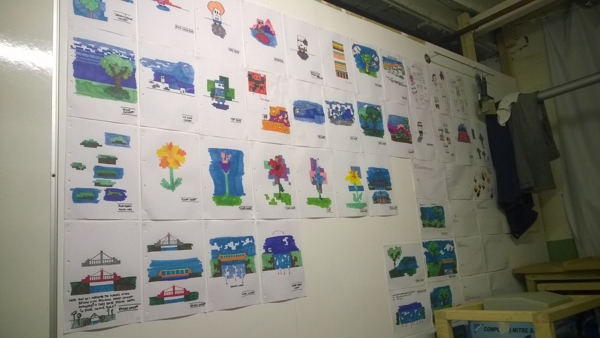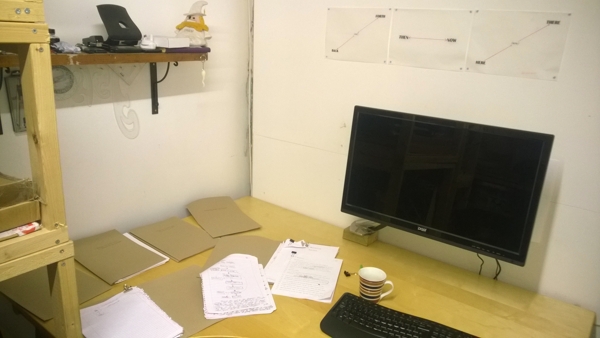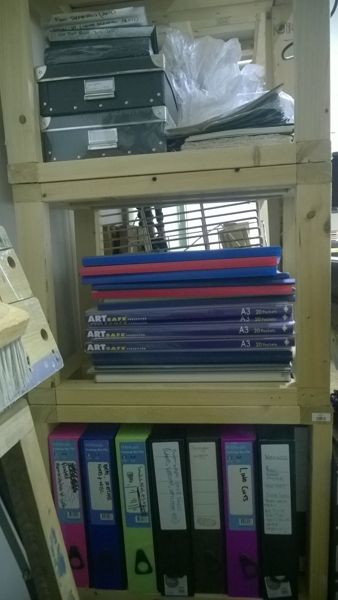For this post, I intend to walk you through my workflow. I do not intend to list
a set of tasks, from one piece to the next. Instead, I aim to present the
mechanics of how I work from a relatively high level. My hope is you will walk
away with a good approximation in what my workflow involves and how I think
about making artwork.
I have two prominent habits which affect how I go about making work –
from inception to creation. The first is: I take a really long time to reach
conclusions. The second is: I spend a lot of time iterating on a multitude of
variations for one piece. The following diagram should help explain what I mean.
 Figure 1: My Workflow (Basic).
Figure 1: My Workflow (Basic).
As alluded to in the previous paragraph, I would describe myself as an iterative
worker. For me, the entry and exit points between inception and creation are
where I spend the least amount of time. The bulk of my time is spent in the
feedback loop (Figure 1). Which is, at times,the cause of some difficulties for
me. The most notable ones are knowing when to stop and identifying when a piece
has branched off into a new idea.
I would like to now switch topics and talk about practical methods for a
moment. These tend to be more consistent but not always. When I note down ideas,
I use loose pieces of paper. Working in a sketch book is something I tend not to
do. The use of separate sheets of paper allows me to see the bigger picture,
literally in some cases. This is because I am able to spread them out over an
entire desk or wall. This act is not the most revolutionary of approaches but
keeping things in a sketchbook increases the chance of me losing something of
interest. I am not one to regularly go through old sketchbooks, and I think I
have developed a hatred for spines in every sketchbook ever made. Therefore, I
usually buy a ream of cartridge paper and use that when needed. This makes it
easy to separate out my ideas on a project-by-project basis.
 Figure 2: Ideas on seperate pieces of loose paper.
Figure 2: Ideas on seperate pieces of loose paper.
 Figure 3: Projects are separated into folders.
Figure 3: Projects are separated into folders.
 Figure 4: Projects are then grouped together into bigger folders (I'm all about folder apparently).
Figure 4: Projects are then grouped together into bigger folders (I'm all about folder apparently).
When an idea begins to gain momentum, I usually enter some form of feedback
loop. Building out mock-ups and seeing how they react (with each iteration and
other artworks I have made). I have, also, become more comfortable (with age)
with taking this part slow and not rushing it. Which was not always the case --
as that last sentence implies.
Knowing how long I hang around in the feedback loop depends on the piece, there
is no hard or fast rule. I simply have to play it by ear and rely on judgement
-- which increases with each new piece I make. A by-product of this is I usually
end up with a collection of pieces which can easily be edited into a
series. Identifying a group of artworks as potential for being displayed as a
series is also another task that has a reliance on judgement.
To help me decide what the final piece(s) is, I stop making and form a shortlist
with the current crop of variations. From there, I leave them displayed in my
studio and see if they can stand up to being on constant display. The time limit
for the artwork(s) to be on show can vary quite dramatically. To give you an
example, sometimes it has been a week and other times it has been a few
months. If the works in the current shortlist don’t seem right, I return to the
start of the loop. Here, I create new work and do so with the insight gleaned
from the pieces of the previous loop(s). I repeat this process until I make
something which feels appropriate or deem the piece a lost cause.
When I feel I have something, I leave the loop and begin thinking about giving
the piece a title. The naming process is just as process driven as the making of
the artwork itself. I jot down potential names and draw up a shortlist. From
there, I let the piece sit with the name. If none of the varieties fit I return
to creating new names and re-draw a shortlist. I repeat the process until a name
is found.
The following diagram is a bit more involved than the loop described
above. Hopefully, it will help clarify any issues or questions you have about
the process.
 Figure 5: My Workflow (Detail).
Figure 5: My Workflow (Detail).
Toward the end of the diagram, the Review box has three options: yes, no and
maybe. Hopefully, you get the general idea of what it means. But, for the sake
of clarity, it is here were I decide whether or not to drop or keep working on
the artwork – or declare it done and date it.
I have mentioned very little about abandoning an idea/artwork, but it does
happen. The reason why most of works do not become abandoned is because of two
major factors. The first one is because I am slow to transition from jotting
down ideas (on single sheets of paper) to iterating and developing it into the
final piece. A by-product of this slowness is that I have time to gather my
thoughts before proceeding. The second one is that most pieces tend to morph
into something else before it hits a dead-end. Whether you call that a dead-end
or not, I’m always left with something to work on.
When explaining where my ideas come from, it is quite easy to talk a lot and not
say much. The reason why is because, when describing the process of reacting to
external stimuli, the answer seems vague. Although, the fact of the matter is I
am simply reacting to external stimuli. For example, as I walk down the street,
I am greeted with the Doppler Effect as cars travel past. Or, a passage in a
book can describe a scene in such a way that I am virtually there. When
presented like this, it is hard to see how or, perhaps more interestingly,
when they fit in to the creation process from the outside. The difficulty with
defining the how or the when to the outsider comes from the lack of consistency
regarding the application of said stimuli. It is almost a case-by-case basis.
������